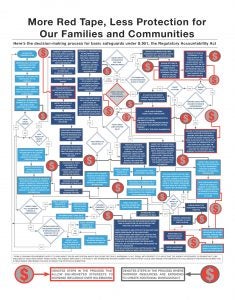FDA is reevaluating its tolerances for lead in food, and food manufacturers should be prepared
By Tom Neltner
By Tom Neltner, J.D., EDF Chemicals Policy Director and Maricel Maffini, Ph.D., Consultant
Until recently, we have known very little about lead exposure from food. Shockingly, a recent report from the EPA found that two-thirds of one-year olds get most of their lead exposure from food. This and other developments in recent years have prompted FDA to reevaluate its procedures regarding lead levels in food. Leading companies should take notice.
We have written about the health risk of lead exposure from major sources such as paint and water and the well-known fact that there is no safe level of lead in the blood of children. We also wrote about what agencies such as the Environmental Protection Agency (EPA) and Centers for Disease Control and Prevention (CDC) are doing to reduce or eliminate persistent sources of lead exposure as recommended by the American Academy of Pediatrics.
 In its recently released FAQs for lead in food, FDA describes what it has done, its current standards and its planned next steps. The agency makes no reference to EPA’s assessment and attributes all of the lead in food to contaminated soil. Because it assumes that the environment is the only source, contamination is unavoidable and lead cannot be removed from the food supply.
In its recently released FAQs for lead in food, FDA describes what it has done, its current standards and its planned next steps. The agency makes no reference to EPA’s assessment and attributes all of the lead in food to contaminated soil. Because it assumes that the environment is the only source, contamination is unavoidable and lead cannot be removed from the food supply.
To limit lead in food to the greatest extent possible, FDA set the following tolerances:
- Bottled water: 5 parts per billion (ppb);
- Juices from berries and other small fruits, including grapes, and passion fruits: 50 ppb;
- Other fruit juices and nectars, including apple: 30 ppb;
- Candy likely to be consumed by small children: 100 ppb; and
- Dried fruits, including raisins: 100 ppb.
Only the bottled water tolerance is established in regulations. For the rest, FDA provides only guidance.
How did FDA set the tolerances?
The 5 ppb limit in bottled water was established by FDA in 1995 based on the inability to reliably measure below that level and that only 2 of 48 (4%) samples collected by FDA exceeded those levels. For comparison, in 2016, the American Academy of Pediatrics recommended lead levels in drinking water at schools be less than 1 ppb.
The fruit juice limits are based on international food standards set by the Codex Alimentarius Commission (Codex), an organization representing 188 countries and the European Union. Those standards were designed to ensure that only about 5% of the juice samples would exceed them. While Codex recognizes the risks posed by lead, its standard was not based on those risks.
For all other foods, FDA relies on a maximum daily intake level of 6 micrograms of lead per day (µg/day) for young children that it established in 1993 based on CDC’s Level of Concern of 10 micrograms of lead per deciliter of blood (µg/dL).
One million children exceed FDA’s current maximum daily intake level
In the FAQs, FDA affirmed that “there is no known identified safe blood lead level” and acknowledges that scientific information has become available in the last decade that indicates neurotoxic effects at low levels of exposure to lead. It notes that the evidence has prompted EPA to lower its air quality standard, CDC to strengthen its standards, and the Joint WHO and FAO Expert Committee on Food Additives (JECFA) to withdraw its limit for lead because it concluded there was no safe level in food. With this backdrop, FDA is reevaluating “its methods for determining when it should take action with respect to measured levels of lead in particular foods, including those consumed by infants and toddlers.”
At EDF, we are pleased to see FDA has undertaken this long overdue reevaluation. EPA’s draft report estimates that more than 5% of children between 2 and 7 years consume more than the 6 µg of lead/day FDA says is tolerable. This estimate excludes drinking water. With 20 million children in those age groups, that means 1 million children exceed the maximum daily intake level. And, by all accounts, this 1993 level does not reflect the mounting scientific evidence that has led other science-based organizations to reduce their standards. We are also encouraged to see that FDA is willing to be more protective of children’s health by conducting its own assessment rather than just following the Codex standards for fruit juices.
Food manufacturers and retailers can better earn consumer trust and avoid more costly reactions to regulations by updating their preventive controls and supply chain management programs now to reduce lead levels in food.


 Among Rick Perry’s first acts as Secretary of Energy was
Among Rick Perry’s first acts as Secretary of Energy was  By Christie Hicks, Manager, Clean Energy Regulatory Implementation
By Christie Hicks, Manager, Clean Energy Regulatory Implementation







